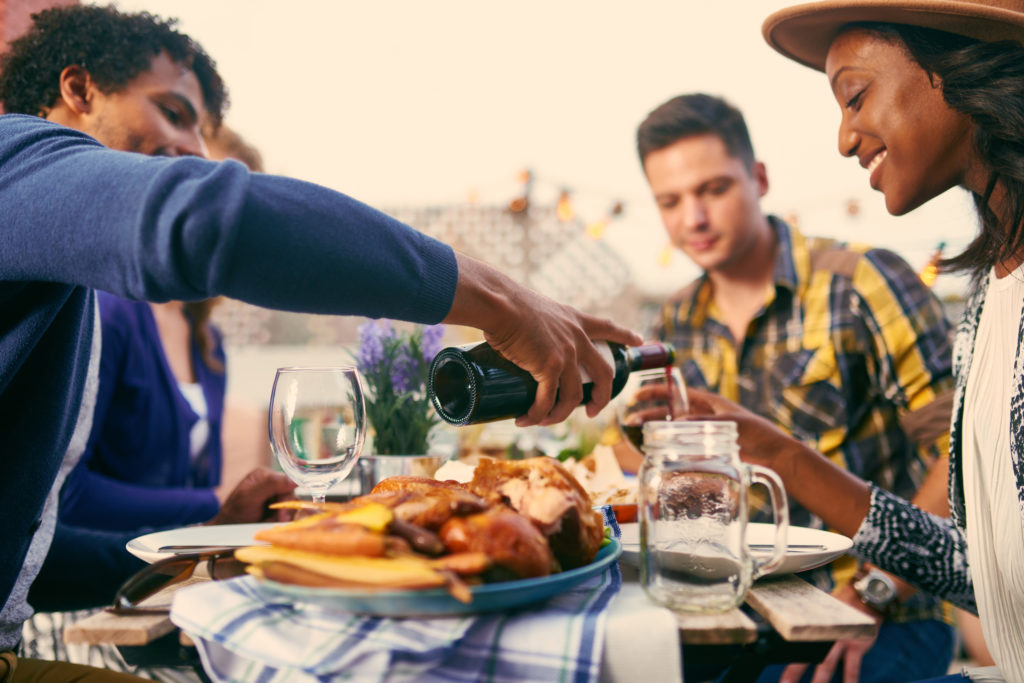One of the vital experiences of which the current pandemic robbed us for too long is the dinner party with friends. Recently my wife and I dined at the home of our dearest friends for the first time in over a year, and the pleasures of friendship, of the table, and simply of time together face to face were like oxygen to us. Soon it will be our turn to reciprocate by cooking for them.
The isolation that began a year ago prompted new ventures in kitchen creativity among some people working from home, when their omission of a daily commute to and from work gave them more time. But I expect that for many people that creativity was evanescent. Remember how short-lived the sourdough craze was? Confined to cooking only for oneself and one’s family, most people’s culinary adventure began to pall a bit after a while. Now that we are beginning again to be able to stretch our talents for guests, our attention turns more keenly to menus that are fitting for the celebration of those friendships that have been too long on ice.
For me, the separation from dear friends over a good meal at home was brought home more acutely by watching Stanley Tucci’s “Searching for Italy” series on CNN. In the series’ six mouthwatering episodes, the actor seeks out and revels in both traditional and innovative samples of foods in the regions of Naples, Rome, Bologna, Milan, Tuscany, and Sicily. Like Tucci, I am of Italian descent—though unlike him, not 100 percent—and his gustatory ecstasies struck me to the heart in these days of culinary monotony. (Tucci’s association as an actor with the subject of food goes back to his roles in films like Big Night and Julie and Julia. Few actors have gotten so much mileage out of eating on camera.)
Reading about food too can be a pleasure in its own right, whether one tries out daring new recipes or not. I have never been a strict recipe-follower in the kitchen, happy instead to vary and improvise, even to invent from time to time. But my small kitchen library has a few notable classics that are as interesting for their authors’ voices as for their instruction in preparing dishes.
Start your day with Public Discourse
Sign up and get our daily essays sent straight to your inbox.Confined to cooking only for oneself and one’s family, most people’s culinary adventure began to pall a bit after a while. Now that we are beginning again to be able to stretch our talents for guests, our attention turns more keenly to menus that are fitting for the celebration of those friendships that have been too long on ice.
My late mother long ago gave me Maria Lo Pinto’s The Art of Italian Cooking, a marvelous little guide first published in 1948. Its relative antiquity means that it is entirely free of present-day obsessions, whether about fats, or carbs, or red meats, or environmental consciousness. It is also unabashedly Catholic, with menus for such events as baptisms, the feast of St. Joseph, and so forth. And like other books written before the dominance of the supermarket in the United States, it offers recipes predicated on the availability of products that are now harder to get than they were seventy-three years ago. Lo Pinto blandly states, for example, “At Easter time whole baby lambs may be purchased from Italian butchers.” Her recipe is not for one of those lambs available at Costco, which require a large outdoor grill to cook; Lo Pinto calls for a whole baby lamb small enough to roast in a household oven, which may be very hard to find outside the largest cities.
A better-known classic nearly as old is The James Beard Cookbook, which has never been out of print since it was published in 1959. Beard was a great guide for cooks at every level, from beginners to the most experienced, and he billed TJBC as “a basic cookbook,” unironically beginning with telling his reader how to boil water! Throughout, his authorial voice is plain, reassuring, and above all explicit, so that his book is very easy to use with confidence. But Beard is uncompromising in his standards, as in this sample: “Probably not one person in a hundred has tasted that delicate tidbit—a properly cooked, tender green bean.” That may still be true today.
By far the most well-traveled book in my library is A Culinary Voyage Through Germany, by Hannelore Kohl, the wife of Helmut Kohl, then the (rather rotund) chancellor of Germany. While living for several months in Korea over twenty years ago, I read of this book’s publication in Germany in the New York Times, and mentioned how much I would like to see it to a German acquaintance I had made in Seoul. She contacted her mother in Germany, who ordered the English translation of the book from the United States and sent it to her daughter in Korea, who sent it on to me in the U.S. around the time I returned home; the book apparently circled the earth before it reached me. Kohl does for Germany what Stanley Tucci is doing for Italy on television, exploring all the varied regional traditions of cooking in her country, from “Friesian smoked loin of pork with pears” to “Saarbrücken meat pie.” And the pages on wurst! Suffice it to say that Frau Kohl’s celebration of German cuisine will not help anyone on a diet.
Not really cookbooks, but not really not cookbooks, are the essay collections of Laurie Colwin, Home Cooking and More Home Cooking, in which the late Gourmet magazine columnist writes simply and affectingly about the centrality of food in everyday life. An obviously talented cook as well as a beautiful writer, Colwin had no patience for the pretentious. “A long time ago,” she writes, “it occurred to me that when people are tired and hungry, which in adult life is much of the time, they do not want to be confronted by an intellectually challenging meal: they want to be consoled.” Amen to that. Colwin was also unafraid to say things others hesitate to utter, for instance paying tribute to England’s “long and grand tradition of cooking” as fine in its own right, whatever the partisans of French or Italian cuisine might say. But above all she wrote as someone who understood the role that cooking and eating play in nourishing the soul as well as the body.
Books about the history of food and drink provide a different kind of pleasure. Colwin, I think, would have appreciated Ned Palmer’s 2019 book A Cheesemonger’s History of the British Isles, which lives up to its billing of telling the reader about cheese through the history of Britain, and about Britain through the history of its cheeses. The agriculture, the biochemistry, and the craft of cheesemaking are the center of Palmer’s storytelling, which takes the reader from the rude huts of crofters to the great industrial producers making cheese today, with plentiful servings of British history for context. A bit of Wensleydale, anyone?
And after a good meal, there are few things as pleasurable as a dram of fine whiskey. Kevin Kosar’s brief but authoritative Whiskey: A Global History is as good an explanation as one can find of how the sublime spirits came originally to be made, what gives each variety its distinctive character, and the role that whiskey has played in the social and political history of the countries that distill the stuff.
Here’s to your health—and to the renewed pleasures of eating and drinking with our friends.













